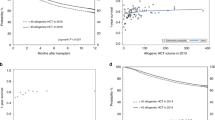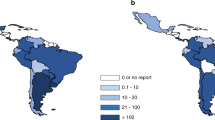Abstract
Hematopoietic cell transplantation (HCT) is a highly specialized, expensive and resource-intense medical procedure that can be associated with racial disparities. We review the prevailing literature on racial disparities in HCT in the United States and describe areas for future research and interventions. We discuss the complexity of interpreting race as a biological and social determinant of disease in biomedical research, especially as it relates to HCT. In the United States, race is often a surrogate for socioeconomic, education and health insurance status. We also discuss some of the nuances to consider while reviewing the literature on racial disparities. Disparities by race exist in three areas related to HCT: donor availability, access to HCT and outcomes of HCT. African-Americans/Blacks have a lower likelihood of finding an unrelated donor. Race and ethnicity definitions are country-specific and reconciling race data can represent significant challenges to unrelated donor registries worldwide. African-Americans/Blacks do not have the same access to autologous and allogeneic HCT as Whites. Racial disparities in outcomes of HCT are more prevalent among allogeneic HCT than autologous HCT recipients. More research is required to understand the biological, social, cultural, medical and financial aspects of race that may influence access to HCT and survival after transplantation. Better understanding of racial disparities will minimize inequities, inform health policy, guide development of interventions targeted to eliminate disparities and ensure equitable access to HCT for all populations.
This is a preview of subscription content, access via your institution
Access options
Subscribe to this journal
Receive 12 print issues and online access
$259.00 per year
only $21.58 per issue
Buy this article
- Purchase on Springer Link
- Instant access to full article PDF
Prices may be subject to local taxes which are calculated during checkout
Similar content being viewed by others
References
Majhail NS, Murphy EA, Omondi NA, Robinett P, Gajewski JL, LeMaistre CF et al. Allogeneic transplant physician and center capacity in the United States. Biol Blood Marrow Transplant 2011; 17: 956–961.
Majhail NS, Omondi NA, Denzen E, Murphy EA, Rizzo JD . Access to hematopoietic cell transplantation in the United States. Biol Blood Marrow Transplant 2010; 16: 1070–1075.
Burchard EG, Ziv E, Coyle N, Gomez SL, Tang H, Karter AJ et al. The importance of race and ethnic background in biomedical research and clinical practice. N Engl J Med 2003; 348: 1170–1175.
Humes KR, Jones NA, Ramirez RR . Overview of race and Hispanic origin: 2010. 2010 Census Briefs, US Department of Commerce, Economics and Statistics Administration, US Census Bureau. March 2011.
Collins FS . What we do and don’t know about ‘race’, ‘ethnicity’, genetics and health at the dawn of the genome era. Nat Genet 2004; 36: S13–S15.
Schwartz RS . Racial profiling in medical research. N Engl J Med 2001; 344: 1392–1393.
Rosenberg NA, Pritchard JK, Weber JL, Cann HM, Kidd KK, Zhivotovsky LA et al. Genetic structure of human populations. Science 2002; 298: 2381–2385.
Jorde LB, Wooding SP . Genetic variation, classification and ‘race’. Nat Genet 2004; 36: S28–S33.
Institute of Medicine. Unequal Treatment: Confronting Racial and Ethnic Disparities in Healthcare. The National Academies Press: Washington, DC, 2003.
Freeman HP . Commentary on the meaning of race in science and society. Cancer Epidemiol Biomarkers Prev 2003; 12: 232s–236s.
Agency for Healthcare Research and Quality. 2010 National Healthcare Disparities Report. US Department of Health and Human Services, Agency for Healthcare Research and Quality: Rockville, MD, 2011.
Mandelblatt JS, Yabroff KR, Kerner JF . Equitable access to cancer services: a review of barriers to quality care. Cancer 1999; 86: 2378–2390.
Shavers VL, Brown ML . Racial and ethnic disparities in the receipt of cancer treatment. J Natl Cancer Inst 2002; 94: 334–357.
Ward E, Jemal A, Cokkinides V, Singh GK, Cardinez C, Ghafoor A et al. Cancer disparities by race/ethnicity and socioeconomic status. CA Cancer J Clin 2004; 54: 78–93.
Albano JD, Ward E, Jemal A, Anderson R, Cokkinides VE, Murray T et al. Cancer mortality in the United States by education level and race. J Natl Cancer Inst 2007; 99: 1384–1394.
Clegg LX, Li FP, Hankey BF, Chu K, Edwards BK . Cancer survival among US whites and minorities: a SEER (Surveillance, Epidemiology, and End Results) Program population-based study. Arch Intern Med 2002; 162: 1985–1993.
Clegg LX, Reichman ME, Miller BA, Hankey BF, Singh GK, Lin YD et al. Impact of socioeconomic status on cancer incidence and stage at diagnosis: selected findings from the surveillance, epidemiology, and end results: National Longitudinal Mortality Study. Cancer Causes Control 2009; 20: 417–435.
American Cancer Society. Cancer Facts &. American Cancer Society: Atlanta, 2011.
Ward E, Halpern M, Schrag N, Cokkinides V, DeSantis C, Bandi P et al. Association of insurance with cancer care utilization and outcomes. CA Cancer J Clin 2008; 58: 9–31.
Egede LE . Race, ethnicity, culture, and disparities in health care. J Gen Intern Med 2006; 21: 667–669.
Williams DR, Mohammed SA, Leavell J, Collins C . Race, socioeconomic status, and health: complexities, ongoing challenges, and research opportunities. Ann N Y Acad Sci 2010; 1186: 69–101.
US Department of Health and Human Services Office of Minority Health. Assuring Cultural Competence in Health Care: Recommendations for National Standards and Outcomes-Focused Research Agenda. US Government Printing Office: Washington, DC, 2000.
Bergstrom TC . Stem cell matching for patients of mixed race; The Selected Works of Ted C Bergstrom 2009. Available at http://works.bepress.com/ted_bergstrom/104 (accessed 15 September 2011).
Maiers M, Gragert L, Klitz W . High-resolution HLA alleles and haplotypes in the United States population. Hum Immunol 2007; 68: 779–788.
NMDP Reports and Statistics. http://insidenmdp/UPDATES/Reports/Documents/2010_Facts_and_Figures_Final1.pdf (accessed 15 September 2011).
Barker JN, Byam CE, Kernan NA, Lee SS, Hawke RM, Doshi KA et al. Availability of cord blood extends allogeneic hematopoietic stem cell transplant access to racial and ethnic minorities. Biol Blood Marrow Transplant 2010; 16: 1541–1548.
Ballen KK, Klein JP, Pedersen TL, Joffe S, Parsons S, Switzer G et al. Relationship of race/ethnicity and survival after single umbilical cord blood transplantation. Blood 2010; 116: Abstract 224.
Joshua TV, Rizzo JD, Zhang MJ, Hari PN, Kurian S, Pasquini M et al. Access to hematopoietic stem cell transplantation: effect of race and sex. Cancer 2010; 116: 3469–3476.
Mitchell JM, Meehan KR, Kong J, Schulman KA . Access to bone marrow transplantation for leukemia and lymphoma: the role of sociodemographic factors. J Clin Oncol 1997; 15: 2644–2651.
Baker KS, Davies SM, Majhail NS, Hassebroek A, Klein JP, Ballen KK et al. Race and socioeconomic status influence outcomes of unrelated donor hematopoietic cell transplantation. Biol Blood Marrow Transplant 2009; 15: 1543–1554.
Baker KS, Loberiza Jr FR, Yu H, Cairo MS, Bolwell BJ, Bujan-Boza WA et al. Outcome of ethnic minorities with acute or chronic leukemia treated with hematopoietic stem-cell transplantation in the United States. J Clin Oncol 2005; 23: 7032–7042.
Hari PN, Majhail NS, Zhang MJ, Hassebroek A, Siddiqui F, Ballen K et al. Race and outcomes of autologous hematopoietic cell transplantation for multiple myeloma. Biol Blood Marrow Transplant 2010; 16: 395–402.
Khaled Y, Abidi MH, Janakiraman N, Kato K, Levine JE, Reddy P et al. Outcomes after auto-SCT in African Americans with multiple myeloma. Bone Marrow Transplant 2009; 43: 845–851.
Khaled Y, Kato K, Janakiraman N, Ferrara JL, Mineishi S . Early relapses do not impact survival after autologous stem cell transplantation in African Americans with multiple myeloma. Bone Marrow Transplant 2007; 39: 727–728.
Mielcarek M, Gooley T, Martin PJ, Chauncey TR, Young BA, Storb R et al. Effects of race on survival after stem cell transplantation. Biol Blood Marrow Transplant 2005; 11: 231–239.
Verma PS, Howard RS, Weiss BM . The impact of race on outcomes of autologous transplantation in patients with multiple myeloma. Am J Hematol 2008; 83: 355–358.
Serna DS, Lee SJ, Zhang MJ, Baker S, Eapen M, Horowitz MM et al. Trends in survival rates after allogeneic hematopoietic stem-cell transplantation for acute and chronic leukemia by ethnicity in the United States and Canada. J Clin Oncol 2003; 21: 3754–3760.
Cavet J, Middleton PG, Segall M, Noreen H, Davies SM, Dickinson AM . Recipient tumor necrosis factor-alpha and interleukin-10 gene polymorphisms associate with early mortality and acute graft-versus-host disease severity in HLA-matched sibling bone marrow transplants. Blood 1999; 94: 3941–3946.
Dickinson AM, Harrold JL, Cullup H . Haematopoietic stem cell transplantation: can our genes predict clinical outcome? Expert Rev Mol Med 2007; 9: 1–19.
Oh H, Loberiza Jr FR, Zhang MJ, Ringdén O, Akiyama H, Asai T et al. Comparison of graft-versus-host-disease and survival after HLA-identical sibling bone marrow transplantation in ethnic populations. Blood 2005; 105: 1408–1416.
Bonow RO, Grant AO, Jacobs AK . The cardiovascular state of the union: confronting healthcare disparities. Circulation 2005; 111: 1205–1207.
Kollman C, Weis T, Switzer GE, Halet M, Kitajima D, Hegland J et al. Non-HLA barriers to unrelated donor stem cell transplantation. Bone Marrow Transplant 2001; 27: 581–587.
Norris K, Nissenson AR . Race, gender, and socioeconomic disparities in CKD in the United States. J Am Soc Nephrol 2008; 19: 1261–1270.
Hwang JP, Lam TP, Cohen DS, Donato ML, Geraci JM . Hematopoietic stem cell transplantation among patients with leukemia of all ages in Texas. Cancer 2004; 101: 2230–2238.
Saraf S, Chen YH, Dobogai LC, Mahmud N, Peace D, Saunthararajah Y et al. Prolonged responses after autologous stem cell transplantation in African-American patients with multiple myeloma. Bone Marrow Transplant 2006; 37: 1099–1102.
Acknowledgements
The CIBMTR is partly supported by Public Health Service Grant/Cooperative Agreement U24-CA76518 from the National Cancer Institute (NCI), the National Heart, Lung and Blood Institute (NHLBI) and the National Institute of Allergy and Infectious Diseases (NIAID) and a Grant/Cooperative Agreement 5U01HL069294 from NHLBI and NCI.
Author information
Authors and Affiliations
Corresponding author
Ethics declarations
Competing interests
The authors declare no conflict of interest.
Rights and permissions
About this article
Cite this article
Majhail, N., Nayyar, S., Santibañez, M. et al. Racial disparities in hematopoietic cell transplantation in the United States. Bone Marrow Transplant 47, 1385–1390 (2012). https://doi.org/10.1038/bmt.2011.214
Received:
Accepted:
Published:
Issue Date:
DOI: https://doi.org/10.1038/bmt.2011.214
Keywords
This article is cited by
-
Evaluating Socioeconomic, Racial, and Ethnic Disparities in Survival Among Patients Undergoing Allogeneic Hematopoietic Stem Cell Transplants
Journal of Racial and Ethnic Health Disparities (2023)
-
Community health status and long-term outcomes in 1-year survivors of autologous and allogeneic hematopoietic cell transplantation
Bone Marrow Transplantation (2022)
-
Efficacy and safety of CAR-T cell therapy in minorities
Bone Marrow Transplantation (2022)
-
Outcomes after hematopoietic cell transplantation among non-English- compared to English-speaking recipients
Bone Marrow Transplantation (2022)
-
Transplant center characteristics and survival after allogeneic hematopoietic cell transplantation in adults
Bone Marrow Transplantation (2020)



